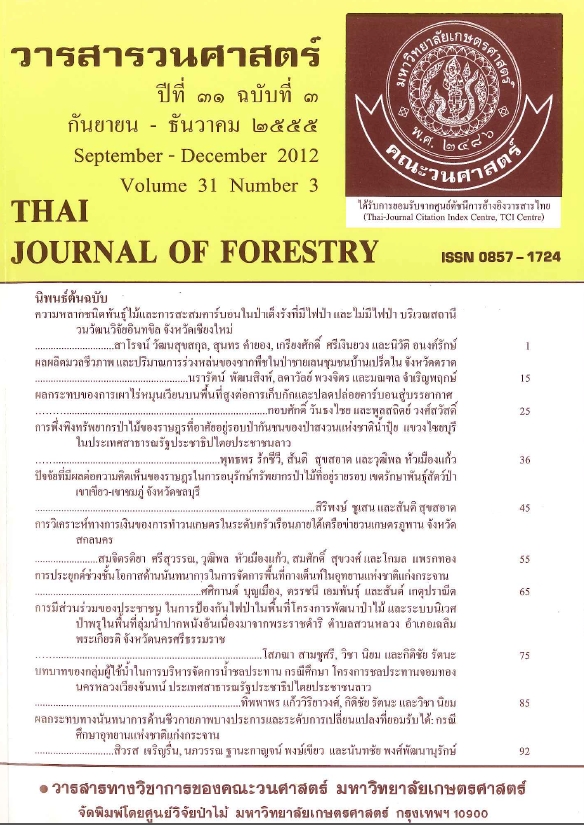ความหลากชนิดพันธุ์ไม้และการสะสมคาร์บอนในป่าเต็งรังที่มีไฟป่า และไม่มีไฟป่า บริเวณสถานีวนวัฒนวิจัยอินทขิล จังหวัดเชียงใหม่
Main Article Content
บทคัดย่อ
การศึกษานี้มีวัตถุประสงค์เพื่อประเมินความหลากชนิดพันธุ์ไม้และการสะสมคาร์บอนในมวลชีวภาพป่าเต็งรังที่มีไฟป่าเกิดขึ้นเป็นประจำทุกปีและป่าเต็งรังที่ไม่มีไฟป่าเกิดขึ้นอย่างน้อย 10 ปี ที่สถานีวนวัฒนวิจัยอินทขิล จังหวัดเชียงใหม่ การประเมินลักษณะของสังคมพืชโดยวิเคราะห์ค่าความถี่ ความเด่น ความหนาแน่น ดัชนีความสำคัญทางนิเวศ และความหลากชนิดพันธุ์ไม้ ตามสมการ Shanon-Wiener index (Krebs, 1985) สำหรับการวิเคราะห์มวลชีวภาพเหนือพื้นดินของป่าเต็งรังวิเคราะห์ตาม Ogino et al. (1967) มวลชีวภาพรากวิเคราะห์ตาม Ogawa et al. (1965) และการสะสมคาร์บอนในมวลชีวภาพวิเคราะห์ตาม Tsutsumi et al. (1983) ผลการศึกษาพบว่า ป่าเต็งรังที่มีไฟป่ามีพันธุ์ไม้ทั้งหมด 42 ชนิด ใน 36 สกุล 22 วงศ์ ไม้พลวงเป็นพันธุ์ไม้เด่นที่มีดัชนีความสำคัญมากที่สุด รองลงมาได้แก่ เต็ง รักใหญ่ เหียง เหมือดหลวง และมะเกิ้ม ดัชนีความหลากชนิดเท่ากับ 3.24 ส่วนป่าเต็งรังที่ไม่มีไฟป่า มีพันธุ์ไม้ทั้งหมด 46 ชนิด ใน 38 สกุล 25 วงศ์ มีไม้พลวงเป็นพันธุ์ไม้เด่นที่สุด รองลงมาคือ เต็ง รักใหญ่ เหมือดหลวง และมะเกิ้ม ดัชนีความหลากชนิดเท่ากับ 3.20 ป่าเต็งรังที่มีไฟป่ามีมวลชีวภาพป่าไม้ 106.6 ตันต่อเฮกแตร์ แยกเป็นมวลชีวภาพลำต้น กิ่ง ใบและราก 68.6, 22.9, 1.9 และ 13.1 ตันต่อเฮกแตร์ ตามลำดับ ปริมาณคาร์บอนสะสมในมวลชีวภาพทั้งหมด 52.6 ตันต่อเฮกแตร์ แยกเป็นส่วนของลำต้น กิ่ง ใบและราก 34.3, 11.1, 0.9 และ 6.3 ตันต่อเฮกแตร์ ตามลำดับ ส่วนป่าเต็งรังที่ไม่มีไฟป่ามีมวลชีวภาพป่าไม้ 128.3 ตันต่อเฮกแตร์ แยกเป็นมวลชีวภาพลำต้น กิ่ง ใบและราก 82.1, 29.3, 2.0 และ 15.0 ตันต่อเฮกแตร์ ตามลำดับ โดยมีปริมาณคาร์บอนในมวลชีวภาพทั้งหมด 63.4 ตันต่อเฮกแตร์ แยกเป็นส่วนของลำต้น กิ่ง ใบและราก 41.0, 14.2, 1.0 และ 7.2 ตันต่อเฮกแตร์ ตามลำดับ เนื่องจากไม่มีไฟป่าเข้าไปรบกวนการเจริญเติบโตของต้นไม้ ทำให้พบไม้ขนาดใหญ่ (ขนาดเส้นรอบวงโตกว่า 100 เซนติเมตร) ในป่าเต็งรังที่ไม่มีไฟป่ามากกว่าบริเวณที่มีไฟป่าเกิดขึ้นเป็นประจำ ปริมาณมวลชีวภาพและการสะสมคาร์บอนในป่าเต็งรังที่ไม่มีไฟป่าจึงมากกว่าป่าเต็งรังที่มีไฟป่าด้วย ดังนั้น หากมีการควบคุมไฟป่าจะมีโอกาสเพิ่มการสะสมคาร์บอนในป่าเต็งรังมากขึ้น
คำสำคัญ: ป่าเต็งรัง ไฟป่า ความหลากหลายของชนิดพันธุ์ไม้ การสะสมคาร์บอน
Downloads
Article Details

อนุญาตภายใต้เงื่อนไข Creative Commons Attribution-NonCommercial-NoDerivatives 4.0 International License.
ข้าพเจ้าและผู้เขียนร่วม (ถ้ามี) ขอรับรองว่า ต้นฉบับที่เสนอมานี้ยังไม่เคยได้รับการตีพิมพ์และไม่ได้อยู่ในระหว่างกระบวนการพิจารณาตีพิมพ์ลงในวารสารหรือสิ่งตีพิมพ์อื่นใด ข้าพเจ้าและผู้เขียนร่วม (ถ้ามี) ยอมรับหลักเกณฑ์และเงื่อนไขการพิจารณาต้นฉบับ ทั้งยินยอมให้กองบรรณาธิการมีสิทธิ์พิจารณาและตรวจแก้ต้นฉบับได้ตามที่เห็นสมควร พร้อมนี้ขอมอบลิขสิทธิ์ผลงานที่ได้รับการตีพิมพ์ให้แก่วารสารวนศาสตร์ คณะวนศาสตร์ มหาวิทยาลัยเกษตรศาสตร์ กรณีมีการฟ้องร้องเรื่องการละเมิดลิขสิทธิ์เกี่ยวกับภาพ กราฟ ข้อความส่วนใดส่วนหนึ่ง หรือ ข้อคิดเห็นที่ปรากฏในผลงาน ให้เป็นความรับผิดชอบของข้าพเจ้าและผู้เขียนร่วม (ถ้ามี) แต่เพียงฝ่ายเดียว และหากข้าพเจ้าและผู้เขียนร่วม (ถ้ามี) ประสงค์ถอนบทความในระหว่างกระบวนการพิจารณาของทางวารสาร ข้าพเจ้าและผู้เขียนร่วม (ถ้ามี) ยินดีรับผิดชอบค่าใช้จ่ายทั้งหมดที่เกิดขึ้นในกระบวนการพิจารณาบทความนั้น”


